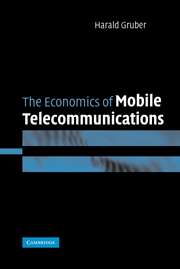Book contents
- Frontmatter
- Contents
- List of figures
- List of tables
- Preface
- List of abbreviations and acronyms
- 1 Introduction
- 2 Stylised features of the mobile telecommunications industry
- 3 The evolution of national markets for cellular mobile telecommunications services
- 4 The determinants of the diffusion of cellular mobile telecommunications services
- 5 Market conduct and pricing issues in mobile markets
- 6 Issues in radio spectrum management
- 7 The evolution of market structure in mobile telecommunications markets
- Appendix
- Bibliography
- Index
Appendix
Published online by Cambridge University Press: 22 September 2009
- Frontmatter
- Contents
- List of figures
- List of tables
- Preface
- List of abbreviations and acronyms
- 1 Introduction
- 2 Stylised features of the mobile telecommunications industry
- 3 The evolution of national markets for cellular mobile telecommunications services
- 4 The determinants of the diffusion of cellular mobile telecommunications services
- 5 Market conduct and pricing issues in mobile markets
- 6 Issues in radio spectrum management
- 7 The evolution of market structure in mobile telecommunications markets
- Appendix
- Bibliography
- Index
Summary
Radio spectrum as a scarce resource
The main economic value of the radio spectrum lies in its capacity to carry information. The radio spectrum is part of the electromagnetic spectrum, which comprises all electromagnetic waves that are transmitted through space. However, not all the spectrum is usable for the purposes of mobile telecommunications. We shall now describe the technical characteristics of the radio spectrum.
Classification of radio spectrum
There are two alternative measurement units for the radio spectrum. Hertz (Hz) indicates the number of wave cycles per second. The alternative is to express radio frequencies in terms of wavelength, which is the ratio between the speed of light through a vacuum (approximately 300 million metres per second) and the radio frequency. The wavelength of a 3 kHz radio wave is thus 100 km, while the wavelength of an 300 GHz radio wave is only 1 mm. Table A1 lists the classification of radio frequencies by names of the waves and their wavelength. In the following, Hertz will be used as a measure.
Radio frequencies are a natural resource. It was only during the course of the first half of the twentieth century, along with development of wireless communications, that radio frequencies became also an economically valuable resource. Wireless communications exploit the properties of the radio spectrum to transmit signals. In fact, before 1930 the radio spectrum was empty of manmade signals. The portion of the spectrum that is technically usable for telecommunications depends on the state of technology.
- Type
- Chapter
- Information
- The Economics of Mobile Telecommunications , pp. 288 - 298Publisher: Cambridge University PressPrint publication year: 2005



